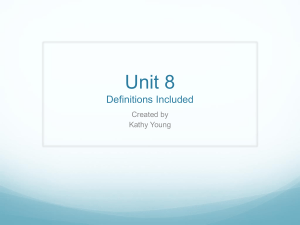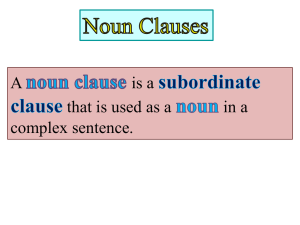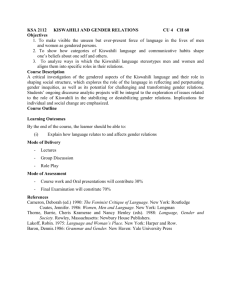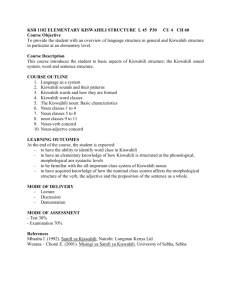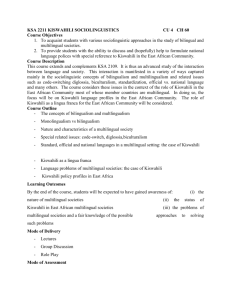description - Marjorie Pak
advertisement
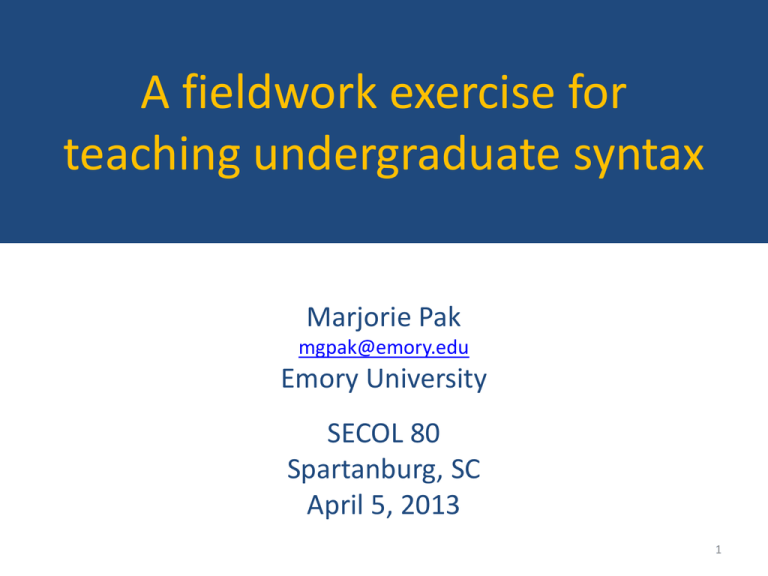
A fieldwork exercise for teaching undergraduate syntax Marjorie Pak mgpak@emory.edu Emory University SECOL 80 Spartanburg, SC April 5, 2013 1 Question 1 What do we want our students to take away from their study of syntax? Question 2 What do they actually take away? 2 3 The ideal balance enough English syntax to get a sense of how rules and trees work + enough cross-linguistic data to get a sense of the range of syntactic variation 4 How to achieve this balance? (It’s hard enough just to teach English syntax!) PROPOSAL: include some exercises on descriptive syntax Get students to recognize, talk and write about properties of a syntactic structure in various languages e.g. How are relative clauses formed in ____? 5 Exercise #1 Translate these sentences into another language. Work with a native speaker if your proficiency is not very high. Use the conventional 3-line notation for linguistic examples we have practiced. What differences do you observe between the way relative clauses are formed in English and in your target language? Supply additional examples to help support any patterns you believe you have observed. Write 1-2 paragraphs. 1) We saw the women [who work at the hospital]. 2) I read the book [that fell off the table]. 3) We saw the women [you visited]. 4) I need the book [that you borrowed]. 6 Preparation: Basic background on relative clauses 1) 2) 3) 4) We saw the women [who work at the hospital]. I read the book [that fell off the table]. We saw the women [you visited]. I need the book [that you borrowed]. A RC is a clause that modifies a noun Many languages have relative markers – Eng. that, who, Ø The noun that the RC modifies is called the head noun. The RC follows the head noun in English. The head noun may be interpreted as the subject or the object of the RC verb. subject RCs in (1)-(2) object RCs in (3)-(4) 7 Follow-up discussion and grading Spend some time in class looking at a sampling of peers’ write-ups together Criteria for grading: Has the student... accurately observed patterns in the target language? appropriately used technical terms learned in class? included examples that support their claims? Students gain exposure to cross-linguistic variation and also practice descriptive writing about observations 8 Exercise #2: Eliciting RCs in an unfamiliar language I scheduled small-group elicitation sessions with a native speaker of Kiswahili a former graduate student paid a small stipend was instructed to speak slowly and clearly but not unnaturally, and not to spell words for students gave permission for students to record (but students should still double-check) 9 The instructor does not need to know Kiswahili. Like other Bantu languages, Kiswahili works well because consonants and vowels are familiar for English speakers and easy to transcribe with IPA agglutinative morphology is an interesting challenge – very different from English but highly transparent unfamiliar to most students but fairly well-studied; online dictionaries, tutorials, etc. are available... ...so the assignment can be tailored to various levels 10 Preparation: Background on Kiswahili morphosyntax Like many other Bantu languages: SVO, pro-drop, agglutinative morphology with multiple noun classes Noun roots in Kiswahili must always occur with a prefix designating the noun class. Noun class is similar to gender – a way of classifying nouns into (arbitrary?) categories that affect the noun itself as well as agreeing adjectives, articles, etc. un-a pulsera bonit-a Spanish a-FEM bracelet[FEM] pretty-FEM ‘a pretty bracelet’ un anillo bonit-o a.MASC ring[MASC] pretty-MASC ‘a pretty ring’ 11 But instead of 2 or 3 genders, Bantu languages have 10+ noun classes! The class of any given noun must be learned and memorized. But it’s not entirely arbitrary… Each even-numbered class is the plural of the preceding (odd-#’d) class Semantic patterns: e.g. class 1 nouns are always people 12 Unlike in Eur. languages, the verb agrees with the subject in noun class. Verb morphology: subject agreement + tense + verb root a-na-fika. ni-li-nunua kiti. _______________ _______________ _______________ ‘He/she arrives’ ‘I bought the chair.’ ‘He/she bought the chairs.’ ‘The chair arrives.’ ‘The chairs arrive.’ 13 (http://mwanasimba.online.fr/E_Chap07.htm) Preparation: a student’s notes 14 1. ST: Okay, um, could you say ‘The teacher buys books’? 2. KS: Mwalimu ananunua vitabu. teacher books CL1.PRES.buy 3. ST: Could you say ‘I saw the books that the teacher buys’? 4. KS: Niliona vitabu ambavyo mwalimu ananunua. (repeats) 1SG.PST.see books REL.CL8 teacher CL1.PRES.buy 5. ST: Could you say ‘The child reads the book’? 6. KS: Mtoto anasoma child kitabu. CL1.PRES.read book 7. ST: Um, could you say ‘I saw the child that reads the book’? 8. KS: Niliona mtoto anayesoma 1SG.PST.see child kitabu. CL1.PRES.REL.CL1.read book 15 If all goes well, students discover... two ways to form RCs in Kiswahili 1) a prefix on the verb anasoma ‘reads’ anayesoma ‘who/that reads’ 2) amba- + noun-class kitabu amba-cho anasoma ‘the book that s/he reads’ Both relative markers show noun-class agreement Both options are reported to be available with both subject and object RCs Our consultant heavily favored option 1 with subject RCs and option 2 with object RCs 16 Grading criteria Students aren’t penalized if the consultant doesn’t happen to produce both structures during their session No penalty for misspellings or incorrect word breaks But they are expected to elicit (and report on) subject and object RCs modifying nouns of various classes In grading, I pay attention to whether students describe their particular group’s findings accurately apply technical terms and discuss concepts accurately (subject vs. object RCs, noun class, etc.) write clearly and include appropriate examples 17 Modifications Advanced students could read background papers on Kiswahili relative clauses and discuss whether this particular speaker conformed to reported patterns. Students watch The Linguists, read excerpts from Bowern 2008 or other books/articles about fieldwork practices, and discuss challenges and limitations of this exercise. For larger classes where small-group sessions aren’t feasible, students could listen to previously recorded sessions, transcribe them and complete a report. And of course, the basic exercise can be adapted to a wide range of languages and linguistic phenomena. 18 What does this kind of exercise achieve? Students learn in-depth about syntactic phenomena in another language A chance to learn about fieldwork practices for programs that don’t have a dedicated Field Methods course Student comments: ‘It made me feel like a linguist.’ ‘It was more difficult than I imagined.’ ‘I now feel like I have some knowledge concerning how to approach languages unfamiliar to me.’ 19 Many thanks to the Emory Program in Linguistics, students in my Fall 2012 LING-242 class, and our patient and generous Kiswahili consultant. References Bowern, Claire. 2008. Linguistic fieldwork: a practical guide. Palgrave McMillan. Demuth, Katherine & Harford, Carolyn. 1999. Verb raising and subject inversion in Bantu relatives. JALL 20, 41-61. Edelsten, Peter, Kula, Nancy & Marten, Lutz. 2010. Swahili relative clauses. Handout from talk given at Colchester which hunt, University of Essex. 20

